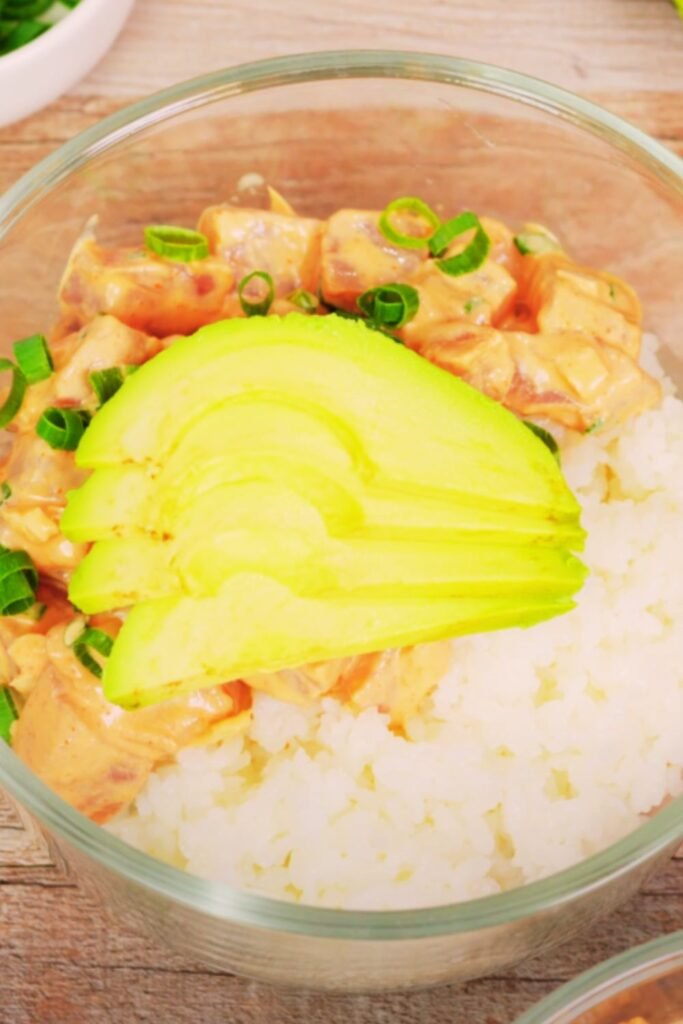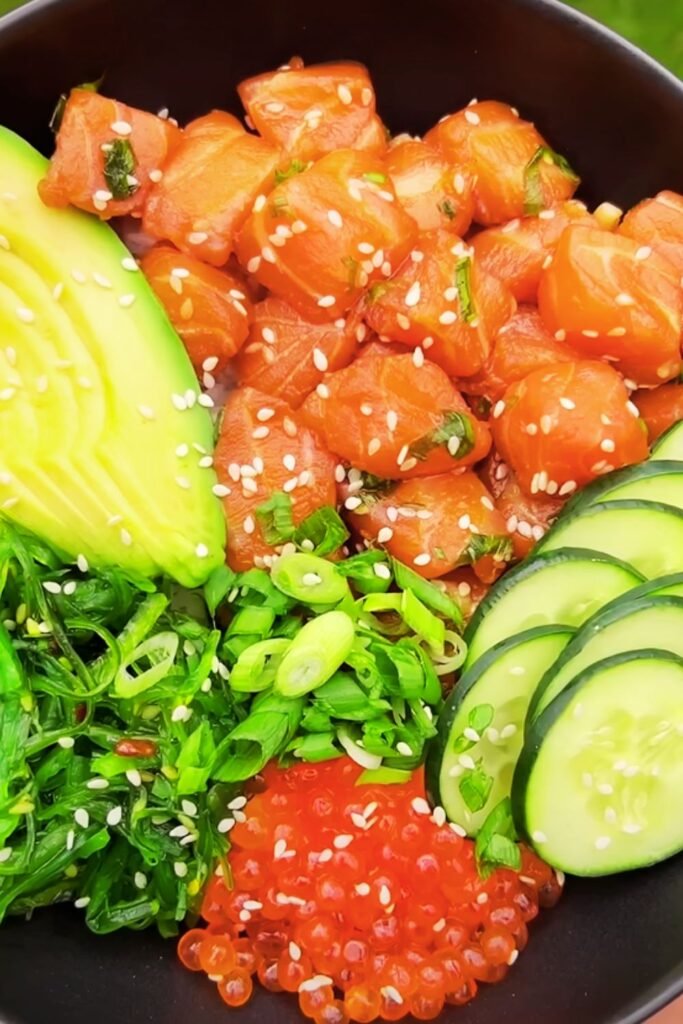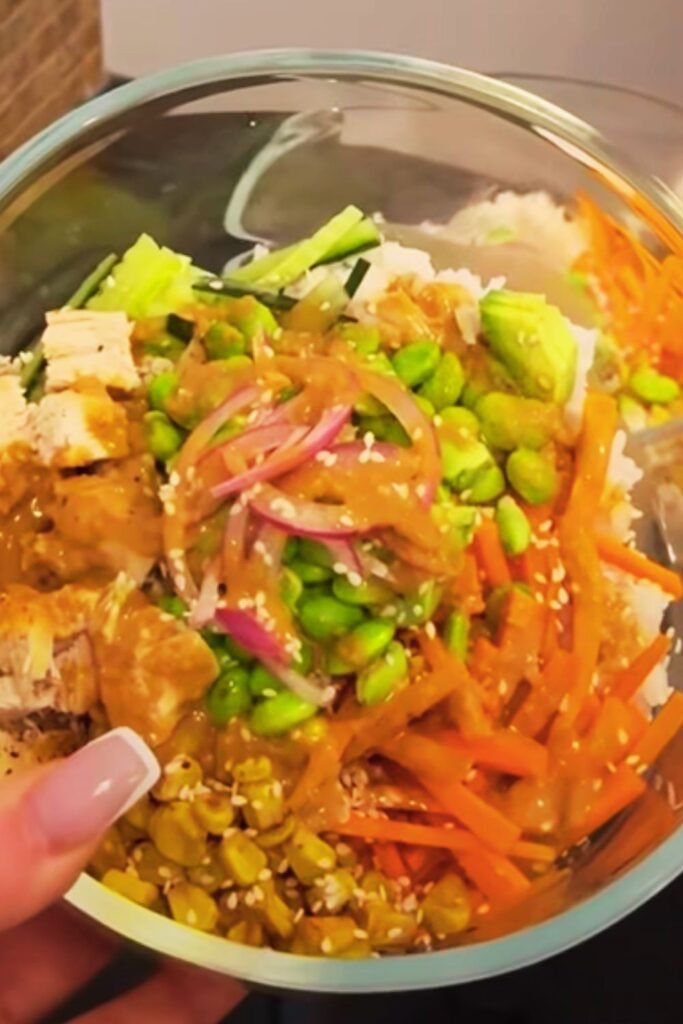When I first discovered poke bowls during my travels to Hawaii, I was immediately captivated by their vibrant colors, fresh ingredients, and the perfect balance of flavors that transported me straight to the islands. The traditional poke bowl, typically made with fresh raw fish, has evolved into countless variations, and today I’m excited to share my favorite adaptation: a Hawaiian-inspired chicken poke bowl that brings all those tropical flavors to your kitchen with easily accessible ingredients.
This recipe combines tender, marinated chicken with fresh vegetables, tropical fruits, and a symphony of Asian-Pacific flavors that’ll make your taste buds dance. What I love most about this dish is how it captures the essence of Hawaiian cuisine while being completely customizable to your preferences and dietary needs.
What Makes This Hawaiian Chicken Poke Bowl Special
My version takes inspiration from traditional Hawaiian poke but uses perfectly seasoned chicken as the protein base. I’ve spent countless hours perfecting this recipe, testing different marinades and combinations until I achieved that perfect balance of sweet, savory, and umami flavors that define authentic Hawaiian cuisine.
The beauty of this dish lies in its versatility and the way each component complements the others. The tender, flavorful chicken provides a hearty protein base, while fresh vegetables add crunch and nutrients. Tropical fruits bring natural sweetness, and the carefully crafted sauce ties everything together with those signature Hawaiian flavors.
Essential Ingredients Breakdown
Protein Base:
- 2 pounds boneless, skinless chicken thighs (preferred over breasts for tenderness)
- 1/4 cup soy sauce (low sodium recommended)
- 2 tablespoons sesame oil
- 1 tablespoon rice vinegar
- 2 cloves fresh garlic, minced
- 1 teaspoon fresh ginger, grated
Bowl Base:
- 3 cups cooked jasmine rice (or brown rice for healthier option)
- 2 cups mixed greens (spinach, arugula, or lettuce)
- 1 large cucumber, diced
- 2 medium carrots, julienned
- 1 cup red cabbage, thinly sliced
Tropical Elements:
- 1 fresh pineapple, cubed (or 2 cups canned chunks, drained)
- 1 ripe mango, diced
- 2 avocados, sliced
- 1/2 cup edamame, shelled and cooked
Signature Poke Sauce:
- 1/4 cup soy sauce
- 2 tablespoons rice vinegar
- 1 tablespoon sesame oil
- 1 tablespoon honey
- 1 teaspoon sriracha (adjust to taste)
- 1 clove garlic, minced
- 1/2 teaspoon fresh ginger, grated
Garnishes and Toppings:
- 2 tablespoons sesame seeds (black and white mixed)
- 4 green onions, thinly sliced
- 1/4 cup macadamia nuts, chopped
- Nori sheets, cut into strips
- Pickled ginger (optional)

Step-by-Step Preparation Guide
Preparing the Chicken (30 minutes active, 2+ hours marinating)
I always start with the chicken because it needs time to marinate and absorb all those wonderful flavors. In my experience, chicken thighs work much better than breasts for this recipe because they stay tender and juicy even when grilled or pan-seared.
First, I combine the soy sauce, sesame oil, rice vinegar, minced garlic, and grated ginger in a large bowl. I whisk these ingredients together until they’re well combined, creating a aromatic marinade that’ll infuse the chicken with authentic Hawaiian flavors.
Next, I cut the chicken thighs into bite-sized cubes, roughly 1-inch pieces. This size ensures even cooking and makes the chicken perfect for eating with chopsticks or a fork. I add the cubed chicken to the marinade, making sure every piece is well coated. I cover the bowl and refrigerate for at least 2 hours, though I prefer to let it marinate overnight for maximum flavor penetration.
Cooking the Perfect Rice Base
While the chicken marinates, I prepare the rice base. I’ve found that jasmine rice works beautifully for this recipe because of its subtle floral aroma and slightly sticky texture that holds the bowl together perfectly. I cook 1.5 cups of dry jasmine rice according to package directions, which typically yields about 3 cups of cooked rice.
For an extra layer of flavor, I sometimes cook the rice in a mixture of water and coconut milk (3:1 ratio), which adds a subtle tropical note that complements the other ingredients beautifully.
Preparing Fresh Vegetables and Fruits
The key to an outstanding poke bowl is having all your vegetables and fruits perfectly prepared and at their peak freshness. I start by washing and drying all my greens thoroughly, then I move on to the other components.
For the cucumber, I dice it into small, uniform pieces, leaving the skin on for extra nutrition and color. The carrots get julienned into thin matchsticks – I use a sharp knife or mandoline for consistent results. The red cabbage needs to be sliced paper-thin; I find that a sharp chef’s knife works better than a food processor for achieving the right texture.
When it comes to the tropical fruits, timing is everything. I cut the pineapple and mango just before serving to maintain their fresh, bright flavors and prevent oxidation. The avocado gets sliced at the very last minute to prevent browning.

Cooking the Marinated Chicken
After the chicken has marinated sufficiently, I remove it from the refrigerator and let it come to room temperature for about 15 minutes. This ensures even cooking throughout.
I heat a large skillet or grill pan over medium-high heat and add a small amount of oil. Working in batches to avoid overcrowding, I cook the chicken pieces for 3-4 minutes per side until they develop a beautiful golden-brown crust and reach an internal temperature of 165°F.
The key here is not to move the chicken too much while it’s cooking – I let it develop that gorgeous caramelized exterior that adds so much flavor and texture to the final dish. Once cooked, I set the chicken aside to rest for 5 minutes before serving.
Creating the Signature Poke Sauce
The sauce is what truly brings this Hawaiian chicken poke bowl together. In a small bowl, I whisk together the soy sauce, rice vinegar, sesame oil, honey, sriracha, minced garlic, and grated ginger until everything is perfectly combined.
I taste the sauce and adjust the flavors as needed – sometimes I add a bit more honey for sweetness, or more sriracha if I want extra heat. The sauce should have a perfect balance of salty, sweet, tangy, and spicy elements that complement rather than overpower the other ingredients.
Assembly Guide for Perfect Presentation
The assembly of a poke bowl is almost as important as the preparation of individual components. I like to think of it as creating an edible work of art that’s as beautiful to look at as it is delicious to eat.
I start by dividing the cooked rice among four bowls, creating a base that covers about half of each bowl. Next, I arrange the mixed greens on one section of the bowl, creating a fresh, colorful foundation for the other ingredients.
Then comes the fun part – arranging all the other components in separate sections around the bowl. I place the cooked chicken in one section, the diced cucumber in another, followed by the julienned carrots, sliced red cabbage, pineapple chunks, mango pieces, and sliced avocado. This creates a beautiful rainbow effect that’s Instagram-worthy and appetizing.
Finally, I add the edamame, sprinkle the sesame seeds over everything, scatter the sliced green onions, add the chopped macadamia nuts, and place strips of nori around the bowl. The pickled ginger goes on the side for those who want an extra zing.

Nutritional Benefits and Health Information
This Hawaiian chicken poke bowl isn’t just delicious – it’s also incredibly nutritious and well-balanced. Let me break down the nutritional benefits of the key components:
Protein Powerhouse: The chicken thighs provide high-quality complete protein, essential for muscle maintenance and growth. Each serving contains approximately 35-40 grams of protein, making this bowl perfect for post-workout meals or anyone looking to increase their protein intake.
Healthy Fats: The avocado, sesame oil, and macadamia nuts provide healthy monounsaturated and polyunsaturated fats that support heart health and help with nutrient absorption.
Complex Carbohydrates: The jasmine rice provides sustained energy, while the vegetables add fiber and essential micronutrients.
Antioxidant Rich: The colorful vegetables and tropical fruits are packed with vitamins, minerals, and antioxidants that support immune function and overall health.
Detailed Nutritional Information Table
| Component | Calories | Protein (g) | Carbs (g) | Fat (g) | Fiber (g) | Key Nutrients |
|---|---|---|---|---|---|---|
| Chicken (6oz) | 285 | 38 | 0 | 13 | 0 | B-vitamins, Iron, Zinc |
| Jasmine Rice (3/4 cup) | 150 | 3 | 33 | 0 | 1 | Manganese, Selenium |
| Avocado (1/2 medium) | 160 | 2 | 9 | 15 | 7 | Potassium, Folate, Vitamin K |
| Pineapple (1/2 cup) | 40 | 0 | 11 | 0 | 1 | Vitamin C, Manganese |
| Mango (1/2 cup) | 50 | 1 | 13 | 0 | 1 | Vitamin A, Vitamin C |
| Mixed Vegetables | 35 | 2 | 7 | 0 | 3 | Various vitamins, minerals |
| Sauce & Toppings | 85 | 3 | 8 | 5 | 2 | Healthy fats, protein |
| Total per Bowl | 805 | 49 | 81 | 33 | 15 | Complete nutrition |
Customization Options and Variations
One of the things I love most about this recipe is how easily it can be customized to suit different tastes, dietary restrictions, and seasonal ingredient availability.
Protein Variations: While chicken is my go-to protein, this recipe works beautifully with other proteins. I’ve made successful versions using grilled salmon, seared tuna, tofu for vegetarians, or even cooked shrimp for a lighter option.
Grain Alternatives: The rice base can be substituted with quinoa, brown rice, cauliflower rice for low-carb diets, or even zucchini noodles for a completely grain-free version.
Seasonal Fruit Swaps: Depending on the season, I sometimes replace the mango and pineapple with other tropical fruits like papaya, passion fruit, or even fresh berries for a different flavor profile.
Spice Level Adjustments: The sriracha in the sauce can be adjusted or replaced with other hot sauces, jalapeños, or completely omitted for those who prefer milder flavors.
Make-Ahead Tips and Storage Guide
This recipe is fantastic for meal prep, and I often make large batches on Sunday to enjoy throughout the week. Here’s how I approach make-ahead preparation:
Chicken Preparation: I marinate and cook the chicken up to 3 days in advance, storing it in the refrigerator in an airtight container. It actually tastes better after a day or two as the flavors continue to develop.
Vegetable Prep: Most vegetables can be prepped 1-2 days ahead. I store the diced cucumber, julienned carrots, and sliced cabbage in separate containers in the refrigerator.
Rice Storage: Cooked rice keeps well in the refrigerator for up to 5 days. I portion it into individual containers for easy assembly.
Sauce Longevity: The poke sauce stays fresh in the refrigerator for up to a week and actually improves in flavor over time.
Final Assembly: I assemble the bowls just before serving to maintain optimal texture and freshness, especially for the avocado and fruits.
Serving Suggestions and Pairings
This Hawaiian chicken poke bowl is substantial enough to serve as a complete meal, but there are several ways to enhance the dining experience:
Side Dishes: I sometimes serve it with miso soup or a light cucumber salad on the side. Seaweed salad also makes an excellent accompaniment that adds to the oceanic theme.
Beverages: The tropical flavors pair beautifully with iced green tea, coconut water, or fresh fruit juices like pineapple or mango juice. For something more sophisticated, I recommend hibiscus tea or a virgin mojito with fresh mint.
Family Style Serving: For gatherings, I create a poke bowl bar where everyone can customize their own bowl. I set out all the components in separate bowls with serving spoons, and guests can build their perfect combination.
Troubleshooting Common Issues
Over the years of making this recipe, I’ve encountered and solved several common issues that home cooks might face:
Dry Chicken: This usually happens when the chicken is overcooked or not marinated long enough. I always use a meat thermometer and don’t cook beyond 165°F. The marinade time is crucial for tender, flavorful chicken.
Mushy Rice: Overcooked rice can ruin the texture of the entire bowl. I cook the rice until just tender and let it rest off the heat for 10 minutes before fluffing with a fork.
Watery Bowl: This happens when vegetables aren’t properly drained or when the sauce is too thin. I always pat vegetables dry and adjust the sauce consistency as needed.
Bland Flavors: The key is in the balance of the sauce and proper seasoning of individual components. I always taste and adjust seasonings before serving.
Advanced Techniques for Restaurant-Quality Results
To elevate this dish to restaurant quality, I employ several professional techniques:
Chicken Technique: I sometimes use a technique called “velveting” where I briefly marinate the chicken in cornstarch and egg white before the main marinade. This creates incredibly tender, silky chicken.
Rice Perfection: I cook the rice with a small amount of rice vinegar and sugar (sushi rice style) which adds subtle flavor and helps the grains maintain their shape.
Knife Skills: Consistent, uniform cuts not only look professional but also ensure even distribution of flavors in each bite.
Temperature Control: I serve components at their optimal temperatures – warm rice and chicken, cool vegetables and fruits – which creates a delightful temperature contrast.
Seasonal Adaptations
I love adapting this recipe to showcase seasonal ingredients:
Summer Version: I add fresh corn kernels, cherry tomatoes, and substitute stone fruits like peaches or nectarines for the tropical fruits.
Fall Adaptation: Roasted sweet potato cubes and pomegranate seeds create a beautiful autumn version with added sweetness and crunch.
Winter Variation: I sometimes add roasted Brussels sprouts and use dried fruits rehydrated in warm coconut milk for a cozy winter feel.
Spring Edition: Fresh pea shoots, radish slices, and early summer berries create a light, refreshing spring version.
Cultural Context and Inspiration
While this recipe is inspired by traditional Hawaiian poke, I want to acknowledge that authentic poke is a sacred dish with deep cultural significance in Native Hawaiian culture. Traditional poke features fresh, raw fish and has been a staple food for Native Hawaiians for centuries.
My chicken adaptation is meant to honor those flavors while making them accessible to home cooks who might not have access to sushi-grade fish or who prefer cooked proteins. I encourage anyone interested in authentic Hawaiian cuisine to seek out traditional recipes and learn about the rich cultural heritage behind these dishes.
Frequently Asked Questions
Q: Can I use chicken breasts instead of thighs? Yes, but I recommend pounding them to even thickness and being very careful not to overcook them. Chicken breasts can become dry quickly, so I suggest using a meat thermometer and removing them from heat at exactly 165°F.
Q: How long does the marinated chicken keep in the refrigerator? The marinated raw chicken should be cooked within 24-48 hours for best quality and safety. Once cooked, it keeps for 3-4 days in the refrigerator.
Q: Can I make this bowl vegetarian or vegan? Absolutely! Replace the chicken with marinated and grilled tofu, tempeh, or extra edamame. For vegan versions, substitute the honey in the sauce with maple syrup or agave nectar.
Q: What’s the best way to cut a fresh pineapple? I cut off the top and bottom, stand it upright, and slice down the sides to remove the skin. Then I quarter it lengthwise and remove the core before cubing the flesh.
Q: Can I use frozen mango instead of fresh? Yes, but make sure to thaw it completely and pat it dry before using. Fresh mango has better texture, but frozen works in a pinch.
Q: How spicy is this recipe? With one teaspoon of sriracha, it’s mildly spicy. You can adjust the heat level by increasing or decreasing the sriracha, or substituting it with your preferred hot sauce.
Q: What if I can’t find macadamia nuts? Cashews, almonds, or even toasted coconut flakes make excellent substitutes. The goal is to add some crunch and richness to the bowl.
Q: Can I prep entire bowls in advance? I don’t recommend assembling complete bowls more than a few hours in advance, as the ingredients can get soggy. It’s better to prep components separately and assemble just before serving.
Q: Is this recipe gluten-free? It can be! Just make sure to use gluten-free soy sauce (tamari) and check that all other ingredients are certified gluten-free.
Q: How do I know when the chicken is properly cooked? The internal temperature should reach 165°F when measured with a meat thermometer. The chicken should also be golden brown on the outside and no longer pink in the center.
This Hawaiian inspired chicken poke bowl has become one of my signature dishes, perfect for everything from weeknight dinners to entertaining guests. The combination of flavors, textures, and colors creates a meal that’s not only nourishing but also brings a little taste of paradise to your table. I hope you enjoy making and eating this recipe as much as I do!